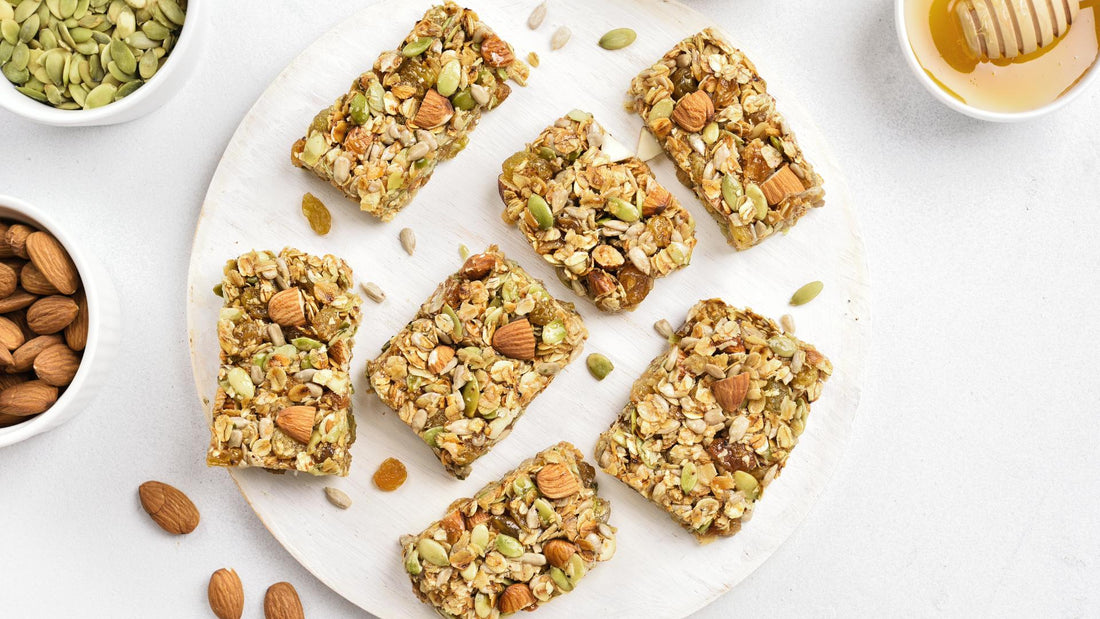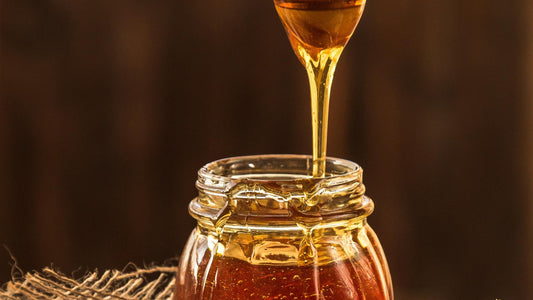
Zurück zur Schule: So kaufen und bereiten Sie nachhaltige Snacks zu
Aktie
Konzentrieren wir uns auf nachhaltige und gesunde Lebensmittel- und Snackauswahl. Studien haben uns bewusst gemacht, dass die Lebensmittelauswahl entscheidend für unseren ökologischen Fußabdruck ist. Daher möchten wir uns die nachhaltige Lebensmittelzubereitung genauer ansehen und Vorschläge und Tipps für Sie und Ihre Familie finden.
Die Sommertage werden immer kürzer und die Schulanfangszeit rückt näher. Es ist Zeit, sich auf ein neues Schuljahr voller Lernen, Wachstum und Heißhunger auf Snacks am Mittag vorzubereiten. Wir verstehen, dass es praktisch ist, zu abgepackten Snacks zu greifen, aber wie Sie vielleicht bereits wissen, sind diese nicht immer die gesündesten Optionen.
Warum nicht dieses Jahr Ihren Snack-Alltag nachhaltig gestalten? Indem Sie Snacks wählen, die nicht nur lecker, sondern auch umweltfreundlich sind, können Sie sowohl Ihre Gesundheit als auch den Planeten positiv beeinflussen. In diesem Leitfaden erkunden wir verschiedene nachhaltige Snackoptionen für den Schulanfang, die Ihnen und Ihrer Familie Energie geben, Sie konzentrieren und Ihren ökologischen Fußabdruck im Auge behalten.
Wir werden uns auf Aspekte von Lebensmitteln wie Saisonalität, Lokalität und Nährwert konzentrieren. Darüber hinaus werden wir uns mehr auf nachhaltige vegetarische Optionen konzentrieren, die die oben genannten Lebensmitteleigenschaften respektieren und in eine nachhaltige Denkweise eingebettet sind. Von nährstoffreichen Häppchen bis hin zu kreativen hausgemachten Leckereien – begeben wir uns auf eine Snack-Reise, die gut für Sie und die Welt um Sie herum ist.
Warum Saisonalität und Lokalität?
Im Kontext der Nachhaltigkeit bezieht sich Saisonalität auf den Verzehr von Lebensmitteln, die in ihrem natürlichen Rhythmus wachsen. Sie entsprechen ihren natürlichen Wachstumszyklen und den lokalen Klimabedingungen. Dabei werden Lebensmittel ausgewählt und genossen, die in einer bestimmten Saison am frischesten und reichlichsten sind. Dieser Ansatz steht im Gegensatz zum modernen Lebensmittelsystem.
Lokalität bezieht sich auf die Praxis, Produkte zu beziehen und zu konsumieren, die in relativ großer geografischer Nähe zum Verbraucher hergestellt werden. Dabei werden Waren bevorzugt, die in derselben Region oder Gemeinde wie der Verbraucher angebaut, hergestellt oder produziert werden.

Saisonalität und Lokalität berücksichtigen
- Geringere Umweltbelastung: Saisonale Lebensmittel werden in der Regel näher am Verbrauchsort angebaut, wodurch der Bedarf an Langstreckentransporten sinkt. Dies führt zu geringeren Treibhausgasemissionen im Zusammenhang mit Transport und Kühlung.
- Erhaltung der Artenvielfalt: Die Wahl saisonaler Produkte unterstützt den Anbau einer größeren Vielfalt an Nutzpflanzen. Dies wiederum trägt zur Erhaltung der Artenvielfalt in der Landwirtschaft bei und bewahrt traditionelle landwirtschaftliche Praktiken, die oft an bestimmte Regionen und Jahreszeiten gebunden sind.
- Unterstützung der lokalen Wirtschaft: Wenn Sie sich für saisonale Lebensmittel entscheiden, kaufen Sie diese eher bei lokalen Bauern und Erzeugern. Dies stärkt die lokale Wirtschaft, fördert nachhaltige landwirtschaftliche Praktiken und schafft stärkere Verbindungen zwischen Erzeugern und Verbrauchern.
- Verbesserter Geschmack und Nährwert: Saisonale Lebensmittel werden auf dem Höhepunkt ihrer Reife geerntet, was zu einem besseren Geschmack und einem höheren Nährwert führt. Obst und Gemüse, das Zeit hatte, sich an der Pflanze vollständig zu entwickeln, ist in der Regel reicher an Vitaminen, Mineralien und Antioxidantien.
- Verbundenheit zur Natur: Saisonales Essen fördert eine tiefere Verbundenheit zur Natur und den Rhythmen der wechselnden Jahreszeiten. Es fördert die Wertschätzung für die Zyklen von Wachstum, Fülle und Erneuerung, die in der Umwelt stattfinden.
- Förderung einer nachhaltigen Landwirtschaft: Die Unterstützung der Saisonalität geht oft mit nachhaltigen landwirtschaftlichen Praktiken einher, bei denen Bodengesundheit, Wasserschutz und ein geringerer Einsatz synthetischer Pestizide und Düngemittel im Vordergrund stehen.
So berücksichtigen Sie Saisonalität und Lokalität
Saisonalität und Lokalität in Ihre Konsumgewohnheiten zu integrieren, ist eine bewusste und lohnende Reise in Richtung Nachhaltigkeit. Hier ist eine Schritt-für-Schritt-Anleitung, die Ihnen dabei hilft, diese Prinzipien in Ihren Lebensstil zu integrieren:
Bilden Sie sich weiter
Wir wissen, dass es ziemlich chaotisch sein kann, sein tägliches Konsumverhalten zu ändern. Angesichts eines normalerweise intensiven Alltags ist es aufgrund der potenziellen Komplexität schwierig, sich für nachhaltigere Lösungen zu entscheiden. Es gibt jedoch einen Weg, dies zu umgehen.
Gehen Sie Schritt für Schritt vor. Wählen Sie Bereiche Ihres Kühlschranks und Ihrer Schränke aus und beginnen Sie, das Muster zu ändern. Sie können beispielsweise mit Obst und Gemüse beginnen. Informieren Sie sich über die Jahreszeiten und die lokalen Produkte in Ihrer Region. Machen Sie sich bewusst, dass Obst, Gemüse und andere Waren natürlich zu unterschiedlichen Jahreszeiten verfügbar sind. Informieren Sie sich über lokale Bauernmärkte, Programme für gemeinschaftsgetragene Landwirtschaft (CSA) und Erzeuger in der Nähe.
Planen, planen und planen
Ich weiß, was Sie denken. Jeder einzelne Aspekt des täglichen Lebens einer Familie ist geplant. Das sollte auch beim Kochen so sein. Und glauben Sie mir, mit der Zeit wird es einfacher; Sie sparen Zeit, Mühe und möglicherweise Geld und Abfall. Planen Sie Ihre Mahlzeiten auf Grundlage der saisonalen Verfügbarkeit. Erstellen Sie einen wöchentlichen oder monatlichen Speiseplan, der saisonale Zutaten enthält. Suchen Sie sich Rezepte aus, bei denen die Produkte der aktuellen Saison die Hauptzutaten sind.
Entdecken Sie Bauernmärkte und lokale Geschäfte
Werden Sie kreativ und erkunden Sie Ihre Nachbarschaft, Stadt oder Ihren Bezirk. Betrachten Sie es als eine lustige Wochenendaktivität. Gehen Sie mit der ganzen Familie auf eine Schnitzeljagd nach regionalen Produkten. Das ist eine großartige Möglichkeit, den gesichtslosen Supermärkten zu entgehen und Ihren Kindern und sich selbst die Chance zu geben, die Lücke zwischen Bauernhof und Teller zu schließen. Besuchen Sie lokale Bauernmärkte, um frische, lokal angebaute Produkte zu entdecken. Sprechen Sie mit Bauern und fragen Sie nach ihren Anbaumethoden. Suchen Sie nach Fachgeschäften, die regionale und saisonale Produkte anbieten.
Werden Sie zum Saisonkonsumenten
Beginnen Sie damit, sich verschiedene Gewohnheiten anzueignen, die Ihr Konsumverhalten verändern können. Ein saisonaler Konsument zu werden, ist einfacher, als es klingt. Es geht darum, die oben genannten Punkte zu kombinieren. Informieren Sie sich, planen Sie und kaufen Sie entsprechend ein. Bewusste Entscheidungen beim Einkaufen zu treffen, ergibt sich aus diesen drei Aspekten. Dann können Sie darauf verzichten, Produkte außerhalb der Saison zu kaufen, die wahrscheinlich von weit her transportiert wurden. Priorisieren Sie Produkte, die zur aktuellen Saison passen. Während der Hochsaison, wenn bestimmte Produkte im Überfluss vorhanden sind, sollten Sie Konservierungsmethoden wie Einmachen, Einfrieren oder Trocknen in Betracht ziehen, um sie das ganze Jahr über genießen zu können.
Unterstützen Sie lokale Lebensmittelinitiativen
Die Bewegung für nachhaltige Lebensmittel wächst. Selbst in Städten gibt es heutzutage Möglichkeiten, näher an die Lebensmittel heranzukommen, die wir kaufen, und an die Menschen, die sie produzieren. Suchen und besuchen Sie lokale Lebensmittelveranstaltungen, Workshops und Versammlungen, die nachhaltige Praktiken fördern und lokale Produzenten feiern. Nehmen Sie, wenn möglich, an Selbstpflück-Farmen oder Gemeinschaftsgärten teil. Bauen Sie Beziehungen zu lokalen Bauern und Produzenten auf. Fragen Sie nach ihren Praktiken und zeigen Sie Anerkennung für ihre Bemühungen. Nehmen Sie an Hofführungen oder Tagen der offenen Tür teil, um den Weg vom Bauernhof bis auf den Tisch zu verstehen. Das ist eine großartige Möglichkeit, Ihre Unterstützung für Menschen zu zeigen, die versuchen, die Kluft zwischen Produzenten und Verbrauchern zu schließen.
Passen Sie Ihren Kochstil an
Betrachten Sie diese Veränderung als Chance, ein nachhaltiger Meisterkoch zu werden. Fordern Sie sich und Ihre Familie heraus, neue Möglichkeiten zu entdecken, saisonale Produkte optimal zu nutzen. Sie werden verblüfft sein, wie viel Kreativität zum Vorschein kommt, wenn Sie ihr eine Chance geben. Passen Sie Ihre Kochtechniken und Rezepte an saisonale Zutaten an. Entdecken Sie neue Geschmacksrichtungen und experimentieren Sie mit verschiedenen Kombinationen. Verwenden Sie saisonale Produkte als Grundlage für Ihre Mahlzeiten und bauen Sie diese auf. Aber verzweifeln Sie nicht; wenn alles scheitert, sind die sozialen Medien und das Internet voller Ideen und Rezepte. Die Bewegung für nachhaltige Lebensmittel wächst und bietet jedem Haushalt viele Lösungen.
Wenn Sie diese Schritte befolgen, sind Sie bereits auf dem besten Weg, einen Lebensstil zu entwickeln, bei dem Saisonalität und Regionalität im Vordergrund stehen. So tragen Sie zu einem gesünderen, nachhaltigeren und engeren Verhältnis zu den Lebensmitteln bei, die Sie verzehren, und der Umwelt, in der Sie leben.
DIY Snacks und Erfrischungen
Ich weiß nicht, wie es Ihnen geht, aber all dieses Gerede über Essen hat mich hungrig gemacht. Für mich persönlich sind Snacks ein wichtiger Bestandteil meines Tages. Ich versuche, mir kreative Möglichkeiten auszudenken, um die Zutaten zu verwenden, die ich zu Hause habe, und verzichte darauf, einfach in den nächsten Laden zu gehen. Wir haben einige Ideen für Snacks und Erfrischungen zusammengestellt, die Sie zu Hause, bei der Arbeit und in der Schule genießen können. Der wichtigste Punkt dabei ist, chemische und künstliche Zusatzstoffe zu vermeiden und sich auf nahrhaftere Optionen mit natürlichen Fetten und Zuckern zu konzentrieren.
Nachfolgend haben wir einige nachhaltige DIY-Snacks und Erfrischungen aufgeführt, die nicht nur die Lebensmittelverschwendung minimieren, sondern auch eine pflanzliche Ernährung fördern.

Gesunde Snackvorschläge für den ganzen Tag
- Obst- und Gemüsechips: Wir alle haben zugegebenermaßen ab und zu Lust darauf. Aber warum abgepackte Chips kaufen, wenn Sie köstliche Varianten zu Hause zubereiten können? Sie können Ihre eigenen Chips aus Obst wie Äpfeln und Birnen oder Gemüse wie Süßkartoffeln und Grünkohl herstellen. Schneiden Sie sie in dünne Scheiben, würzen Sie sie mit Kräutern und Gewürzen und backen Sie sie im Ofen, bis sie knusprig sind. Sie sind nicht nur eine gesündere Option, sondern Sie können sie auch nach Ihren Wünschen anpassen und mit verschiedenen Geschmacksrichtungen und Kombinationen experimentieren.
- Selbstgemachte Müsliriegel: Ein persönlicher Favorit. Ich könnte von Protein- und Müsliriegeln leben. Sie sind eine großartige Möglichkeit, Ihre Protein- und Ballaststoffaufnahme während des Tages zu erhöhen. Sie können ganz einfach Ihre eigenen Müsliriegel aus Hafer, Nüssen, Samen, Erdnussbutter, Tahini, Trockenfrüchten und einem natürlichen Süßstoff wie Ahornsirup herstellen. Passen Sie sie Ihrem Geschmack an und verpacken Sie sie in wiederverwendbare Behälter.
- Studentenfutter: Das einfachste von allen, und Sie müssen nicht einmal wandern gehen, um es zu bekommen. Mischen Sie Nüsse, Samen, Trockenfrüchte und vielleicht einige dunkle Schokoladenstückchen für einen sättigenden und tragbaren Snack. Verpacken Sie es in wiederverwendbare Beutel für unterwegs. Eine großartige Quelle für Protein und gesunde Fette, die Sie in Schwung halten und Ihnen den ganzen Tag über Energie geben, in der Schule, bei der Arbeit oder im Fitnessstudio.
- Gemüse-Hummus-Wraps: Sandwich als Schulsnack? Das ist so 90er-mäßig. Die Ära der Wraps ist angebrochen. Verwenden Sie Tortillas, große Salatblätter oder Blattkohl als Wraps. Füllen Sie sie mit hausgemachtem Hummus, geraspeltem Gemüse, etwas Käse und Ihrem bevorzugten pflanzlichen Protein für einen erfrischenden und nahrhaften Snack. Es ist eine einfache und sehr schnelle Möglichkeit, Mahlzeiten für die ganze Familie vorzubereiten, um unterwegs ein nahrhaftes und leichtes Mittagessen zu haben.
- Grüne Smoothies: Smoothies werden schnell zur Lieblingsmahlzeit und zum Lieblingssnack. Sie sind eine einfache Möglichkeit, Ihren Körper mit Vitaminen, Proteinen, gesunden Fetten und Kohlenhydraten zu versorgen. Mischen Sie Blattgemüse mit Früchten, einem Schuss pflanzlicher Milch und vielleicht einigen Samen oder Nussbutter für einen nährstoffreichen und köstlichen Snack.
Snacken mit nachhaltigem Mindset
Zusammenfassend kann man sagen, dass die Bedeutung des lokalen und saisonalen Einkaufs für gesunde Snacks für die Schule und den täglichen Verzehr nicht genug betont werden kann. Indem wir uns dafür entscheiden, lokale Landwirte zu unterstützen und saisonale Produkte auszuwählen, können wir die Nachhaltigkeit fördern. Darüber hinaus profitieren wir von zahlreichen Vorteilen für unsere Gesundheit, unsere Gemeinschaft und die Umwelt.
Aus ökologischer Sicht verringert die Wahl saisonaler und regionaler Zutaten den CO2-Fußabdruck, der mit der Produktion und dem Transport von Lebensmitteln verbunden ist. Indem wir die Entfernung verkürzen, die unsere Lebensmittel zurücklegen, um auf unsere Teller zu gelangen, verringern wir die Treibhausgasemissionen und fördern die Nachhaltigkeit, was sich positiv auf unseren Planeten auswirkt.
Der Einkauf regionaler und saisonaler Lebensmittel zur Zubereitung gesunder Snacks für die Schule ist eine einfache, aber wirkungsvolle Möglichkeit, unsere Gesundheit zu verbessern, unsere Gemeinschaften zu unterstützen und zu einem nachhaltigeren und widerstandsfähigeren Lebensmittelsystem beizutragen. Indem wir im Lebensmittelgeschäft bewusste Entscheidungen treffen, können wir köstliche, nahrhafte Snacks genießen und gleichzeitig eine aktive Rolle bei der Gestaltung einer besseren, gesünderen Zukunft für uns selbst und kommende Generationen spielen.

Artikel von Alexis Damdimopoulos. Kurz gesagt, ich bin süchtig nach der Natur. Ich interessiere mich leidenschaftlich für alles, was mit Lebensmitteln zu tun hat, von ihrer Produktion bis hin zur ethischen Einstellung, sie nicht zu verschwenden. Ich glaube an eine nachhaltige, ethische und zirkuläre Denkweise. Treffen wir uns im GC9-Blog!




